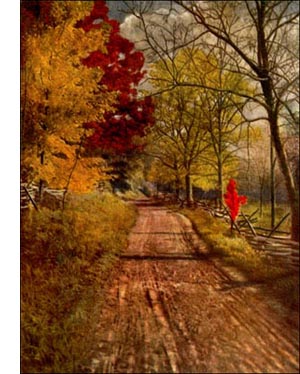Tideland Spruce or Sitka Spruce Tree
 Tideland Spruce, Sitka Spruce (Picea Sitchensis, Carr.)-Tree with tapering trunk and enlarged base, 100 to 200 feet high, with broadly pyramidal head of drooping branches. Bark reddish brown, thin, scaly. Wood light, soft, straight grained, satiny, light reddish brown. Buds lustrous, scaly, conical, 1/4 to 1/2 inch long. Leaves silvery white above, green beneath, 1/2 to 1 inch long, flattened, twisted, pointed, horny tipped, all around the twig. Flowers : staminate on side twigs, abundant, dark red, conical, 3/4 to 1 1/2 inches long; pistillate on terminal twigs of upper branches, smaller, oblong. Cones annual, stalked, pendant, 3 to 5 inches long, with elongated scales toothed at tips, fall in winter. Preferred habitat, moist, sandy soil; swamps. Distribution, coast region, Alaska to Cape Mendocino in California. Uses: Important lumber for interior woodwork in buildings, boat building, woodenwares, cooperage and fencing. Ornamental tree in Europe, and in the warmer parts of the eastern United States. Most important lumber in Alaska. Used for fuel, construction of buildings, boats, and fencing, wooden utensils and boxing.
Tideland Spruce, Sitka Spruce (Picea Sitchensis, Carr.)-Tree with tapering trunk and enlarged base, 100 to 200 feet high, with broadly pyramidal head of drooping branches. Bark reddish brown, thin, scaly. Wood light, soft, straight grained, satiny, light reddish brown. Buds lustrous, scaly, conical, 1/4 to 1/2 inch long. Leaves silvery white above, green beneath, 1/2 to 1 inch long, flattened, twisted, pointed, horny tipped, all around the twig. Flowers : staminate on side twigs, abundant, dark red, conical, 3/4 to 1 1/2 inches long; pistillate on terminal twigs of upper branches, smaller, oblong. Cones annual, stalked, pendant, 3 to 5 inches long, with elongated scales toothed at tips, fall in winter. Preferred habitat, moist, sandy soil; swamps. Distribution, coast region, Alaska to Cape Mendocino in California. Uses: Important lumber for interior woodwork in buildings, boat building, woodenwares, cooperage and fencing. Ornamental tree in Europe, and in the warmer parts of the eastern United States. Most important lumber in Alaska. Used for fuel, construction of buildings, boats, and fencing, wooden utensils and boxing.The swamps of the tidewater regions of the Northwest, the rocky slopes (if well watered) of the Alaskan ranges of mountains facing the sea, are clothed with forests of this remarkable tree. Like the bald cypress of the Southeast and the pumpkin ash of the valley of the Arkansas, this lover of swamps is buttressed and much enlarged at its base. The indomitable hardihood of the species is shown where it climbs from sea level to an altitude of 3,000 feet, and follows the coast to the northernmost point reached by any conifer. The tree dwindles to a starveling shrub when the limits of its range are reached, but in the coast regions of Oregon and Washington it is one of the largest and most beautiful of the Western conifers. The graceful sweep of its wide-spreading lower limbs gives a constant and delightful play of light and shadow, owing to the lustrous sheen on the upper sides of the leaves.
In spite of all efforts to grow it in the East, it seems to suffer from summer heat and drought and winter cold. It grows in Boston if protected, but needs a great deal of coddling there.